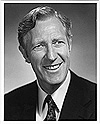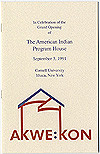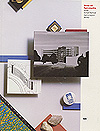Symbols of the University | The Cornell Public Library | Cornell’s Twelve Presidents | | Andrew Dickson White, President, 1866-1885 | | Charles Kendall Adams, President, 1885-1892 | | Jacob Gould Schurman, President, 1892-1920 | | Livingston Farrand, President, 1921-1937 | | Edmund Ezra Day, President, 1937-1949 | | Deane Waldo Malott, President, 1951-1963 | | James Alfred Perkins, President, 1963-1969 | | Dale Raymond Corson, President, 1969-1977 | | Frank Howard Trevor Rhodes, President, 1977-1995 | | Hunter Ripley Rawlings III, President, 1995-2003 | | Jeffrey Sean Lehman, 2003-2005 | | David J. Skorton, 2006 | Inaugurating the Presidents |
| Cornell’s Twelve Presidents Frank Howard Trevor Rhodes, President, 1977-1995 Frank H. T. Rhodes created a vigorous recruitment program for new faculty members, with a strong affirmative action component. A wide variety of new interdisciplinary centers and programs, including the Center for the Environment, the Cornell Institute for Social and Economic Research (CISER), and the Peace Studies Program, encouraged interdisciplinary research and study.
Cornell created research alliances with industry, government, and other institutions in the Center for Theory and Simulation in Science and Engineering and the Cornell Biotechnology Program. The university improved academic support services, especially the library and computer services. The Carl A. Kroch Library was built to house the libraryís Asia collections and the Division of Rare and Manuscript Collections. Conversion, renovation, and new construction enhanced campus facilities and improved landscaping and grounds care renewed Cornelliansí pride in the campus. The Center for Theater Arts revitalized the universityís cultural life.
Cornell strengthened its international presence and stature, stressing the international nature of both education and research and facilitating international interchange. The U. S. Department of Education designated the Africana Studies and Research Center, the Latin American Studies Program, the South Asia Program, the Southeast Asia Program, and the Western Societies Program as national resource centers, and research projects became increasingly global in scale. In 1995, Cornell had a total of 19,144 graduate and undergraduate students, and an operating budget of $1.2 billion. The endowment rose from $271.5 million in 1977 to $1.3 billion in 1994. President Rhodes galvanized alumni support and enthusiasm, successfully completing two major fund-raising campaigns, building strong advocacy in Albany, and representing Cornellís interests in Washington.
Frank H. T. Rhodes was born in 1926 in Warwickshire, England. He received a bachelor of science degree in 1948 from the University of Birmingham, and a Ph.D. in 1950. He went to the University of Illinois as a postdoctoral fellow and Fulbright scholar. From 1951 to 1954 he was a lecturer in geology at the University of Durham. He returned to the University of Illinois to teach from 1954 until 1956. In 1956 he went to the University of Wales, Swansea as professor of geology, going on to serve as head of the geology department, and, in 1967, as dean of the faculty of science. In 1968 he joined the faculty of the University of Michigan, where he became dean of the College of Literature, Science and the Arts, and then vice president for academic affairs. He served as Cornellís ninth president from 1977 until his retirement in 1995. << Prev | Next >> |  + +
Frank Howard Trevor Rhodes
Frank H. T. Rhodes, ca. 1977. 
 + +
Commencement
Commencement, 1982. Frank Rhodes shakes the hand of a graduating senior. 
 + +
Space Sciences
Space Craft Planetary Imaging Facility, Space Sciences, 1980. 
 + +
The Center for Theater Arts
James Stirling, President Rhodes, and Alain Seznec, dean of the College of Arts and Sciences planning the Center for Theater Arts, 1984. 
 + +
The American Indian Program's Akwe:kon
Opened in 1991, Akwe:kon, (pronounced ''a-gway'-go'', it means ''all of us'' in Mohawk Iroquois) is the first university residence of its kind in the country purposely built to celebrate Native American heritage.
Developing diversity on campus was a major goal for President Rhodes. Minority students now make up one-quarter of undergraduate population. In 1988 he wrote the report of the Commission on Minority Participation in Education and American Life, which he chaired. The report made an impassioned call for full integration of African Americans, Hispanics, American Indians, and Asian Americans into the American education system. President Rhodes was actively involved in the creation of the American Indian Program at Cornell as well as of Asian American and Hispanic American Studies. 
 + +
Kroch Library
The new library on the Arts Quad was built underground. 
 + +
The Carl A. Kroch Library
The Carl A. Kroch Library opened in August, 1992. It houses the Cornell University Library's Division of Rare and Manuscript Collections and the Division of Asia Collections. Named for Carl A. Kroch '35, the building was designed especially for the storage of rare and fragile materials. In its 97,000 square feet, the Kroch Library has room for approximately 1.3 million volumes and 20,000 cubic feet of manuscript material. 
 + +
Rhodes Hall
The home for the Cornell Theory Center is Rhodes Hall, designed by architect Charles Gwathmey in 1990. The Theory Center is a high-performance computing and interdisciplinary research center. 
|
